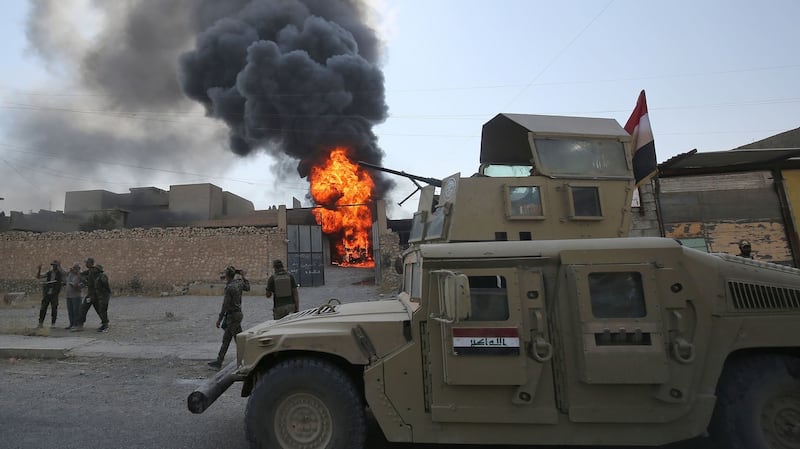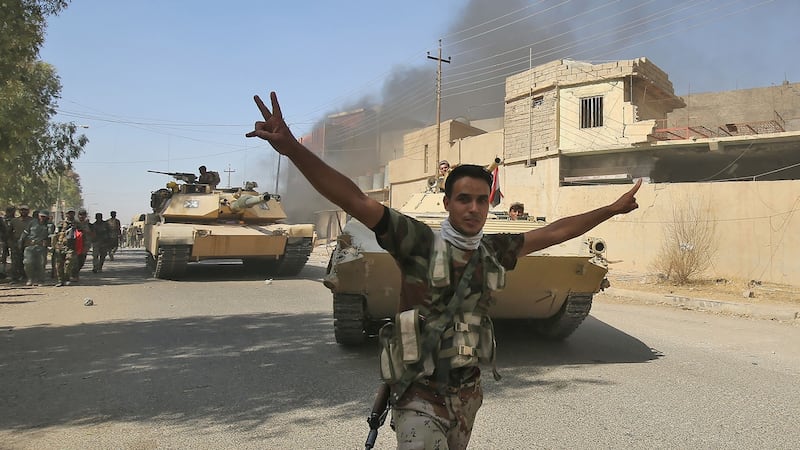Iraqi forces raised the national flag on Saturday in the heart of Tal Afar, Islamic State’s stronghold in Iraq’s northwest, and said they were poised to take full control of the city after a week-long offensive.
Tal Afar is the latest objective in the US-backed war on the jihadist group following the recapture in July of Mosul, where it had declared its self-proclaimed caliphate in parts of Iraq and Syria in 2014.
Tal Afar was cut off from the rest of IS-held territory in June and the campaign to recapture it started on August 20th, when up to 2,000 militants were believed to be defending it against about 50,000 attackers, according to western military sources.
“Tal Afar city is about to fall completely into the hands of our forces, only five per cent remains” under Islamic State control, an Iraqi military spokesman told Reuters.
Elite forces had liberated the heart of the city “and raised the national flag on top of the citadel building”, a statement from the Iraqi joint operations command said.
Destroyed by militants
Much of the Ottoman-era citadel was destroyed by the militants in 2014.
Such a quick collapse of Islamic State in the city, which has been a breeding ground for jihadist groups, would confirm Iraqi military reports that the militants lack command and control structures west of Mosul.
A Reuters visuals team in Tal Afar said fighting had eased on Saturday, with just occasional artillery rounds heard. There was no sign of civilians in two neighbourhoods it visited.

"God willing, the remaining part will be liberated soon," Iraqi foreign minister Ibrahim al-Jaafari said earlier at a news conference with his French counterpart, Jean-Yves Le Drian, and French defence minister Florence Parly, in Baghdad.
Iraqi security forces had retaken 27 out of 29 neighbourhoods in Tal Afar by Saturday evening, but in two neighbourhoods on the northeast side fighting was continuing, a statement from the Iraqi joint operations command said.
Several villages north of Tal Afar have yet to be retaken, the statement said.
The city, which had a pre-war population of about 200,000, lies on the supply route between Syria and Mosul, 80km (50 miles) to the east.
It experienced cycles of sectarian violence between Sunnis and Shia after the US-led invasion of Iraq in 2003, and has produced some of Islamic State’s most senior commanders.

The next target
Mosul’s collapse effectively marked the end of Islamic State’s “caliphate”, but the group remains in control of territory on both sides of the Syrian-Iraqi border, and of Hawija, a city between Mosul and Baghdad that Iraqi officials said would be the next target.
The group is also retreating in Syria, where it is facing two separate offensives, one backed by the US and the other by Russia and Iran.
The number of civilians believed to have remained in Tal Afar at the start of the offensive was estimated at between 10,000 and 20,000 by the US military.
Tens of thousands of people are believed to have fled in the weeks before the battle started. Those remaining were threatened with death by the militants, according to aid organisations and residents who managed to leave.
On Tuesday, UN refugee agency the UNHCR said residents were arriving at refugee camps starving and with wounds from sniper fire and mine explosions.
Residents who fled Tal Afar seven days ago told Reuters on Saturday they had been surviving on bread and dirty water.
“I lost 25kg in the last three months,” said Hajji Abu Mohammad, who escaped last Saturday with his wife and five children.
Reuters











